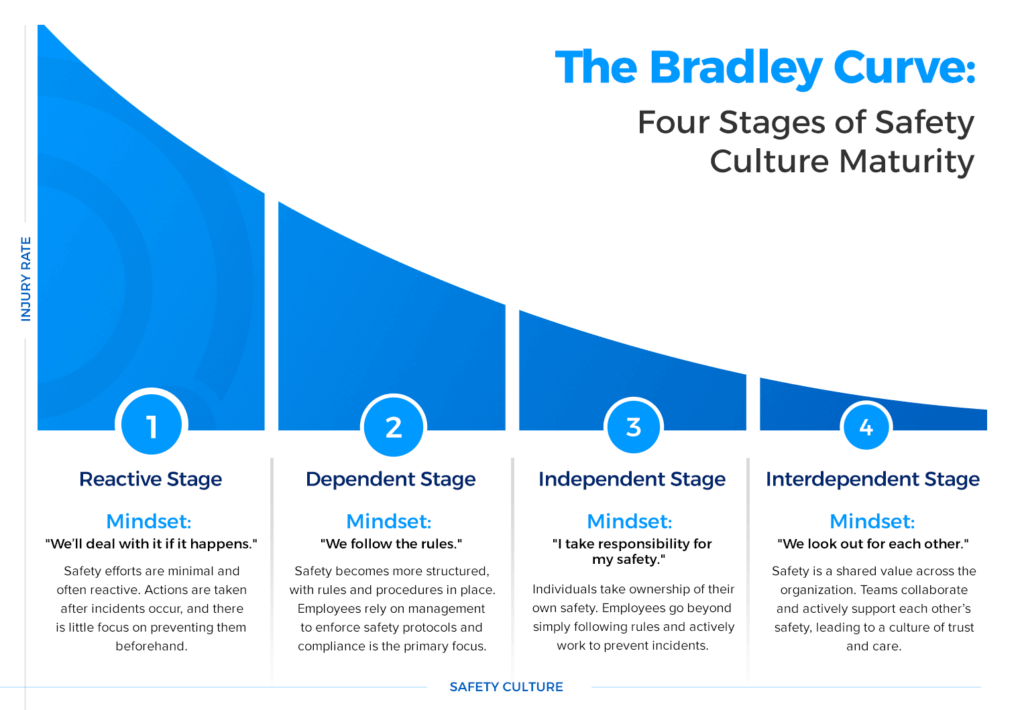
The Bradley Curve: A Journey to Safety Culture Maturity
When it comes to workplace safety, progress isn’t just about rules and regulations. It’s about how deeply safety is ingrained in your organization’s culture. This is where the Bradley Curve comes in. Developed by DuPont, the Bradley Curve shows the different stages of safety culture maturity, from basic compliance to a truly safety-driven mindset.
In this article, we will discuss more about the Bradley Curve and how it can help organizations move towards a culture where safety is a shared value, driving improvements in both performance and morale.

The Four Stages of the Bradley Curve
The Bradley Curve breaks safety culture into four key stages. Each stage reflects the attitudes, behaviors, and levels of engagement employees have towards safety. Here’s a breakdown:
1. Reactive Stage
- At this stage, organizations react to incidents. Safety efforts are often only ramped up after an accident happens.
- Employees see safety as a regulatory requirement. There’s little personal responsibility for preventing accidents.
- Key mindset: “We’ll deal with it if it happens.”
2. Dependent Stage
- Rules and procedures begin to take center stage. Organizations start focusing on compliance.
- Safety is seen as management’s responsibility. Employees follow the rules but don’t take extra steps on their own.
- Key mindset: “We follow the rules.”
3. Independent Stage
- At this stage, individuals take ownership of their own safety. They go beyond just following rules.
- Employees begin to show proactive behavior—spotting risks before they turn into incidents.
- Key mindset: “I take responsibility for my safety.”
4. Interdependent Stage
- Here, safety is a shared value across the organization. People look out for one another.
- Teams actively collaborate to ensure safety, creating a tight-knit culture of trust and care.
- Key mindset: “We look out for each other.”
How to Progress Through the Stages
Moving from one stage to the next isn’t automatic. It takes effort, leadership, and a commitment to cultural change. But with the right steps, any organization can advance to the next level. It’s a journey that requires not just policies but also mindset shifts, from compliance to collaboration.
- From Reactive to Dependent: Start by enforcing strict safety procedures. Ensure employees understand the importance of compliance.
- From Dependent to Independent: Encourage personal responsibility. Offer safety training that goes beyond the basics, empowering employees to act independently.
- From Independent to Interdependent: Foster collaboration. Build a culture where safety is a team effort, and people feel accountable for each other’s well-being.
Why Advancing on the Bradley Curve Matters
The benefits of moving up the Bradley Curve are clear. Advancing from one stage to another isn’t just about reducing incidents; it’s about building a culture that values safety as a core component of success. This cultural shift impacts everything from employee satisfaction to overall operational efficiency.
- Fewer incidents: As safety awareness increases, accidents become rarer.
- Higher morale: A strong safety culture boosts employee confidence and engagement.
- Better performance: A safe environment leads to smoother operations and fewer disruptions.
How to Measure Your Progress
So, how do you know where you stand on the Bradley Curve? It’s all about observation and feedback. You need to track how safety is perceived and acted upon in your organization. Using data and employee input, you can accurately gauge the maturity of your safety culture and chart your path forward.
- Survey your employees. Ask them how they perceive safety in the workplace.
- Track incident reports. See if your organization is becoming more proactive in addressing risks.
- Monitor safety engagement. Are employees more involved in safety discussions and initiatives?
Practical Steps to Improve Safety Culture
Here are some quick wins for each stage of the curve. Whether you’re just starting out or trying to push your team to the next level, focusing on small improvements can make a big difference. Start with foundational changes and build on them to create a culture that truly values safety.
- For Reactive organizations: Conduct regular safety audits and start a reporting system for near-misses.
- For Dependent organizations: Implement safety incentives and recognize employees who follow procedures.
- For Independent organizations: Offer leadership training to employees who take safety into their own hands.
- For Interdependent organizations: Encourage peer-to-peer safety reviews and create team challenges to promote collaboration.
Conclusion
The Bradley Curve offers a clear roadmap to safety culture maturity. Whether your organization is just starting out or looking to fine-tune its safety approach, understanding where you are on the curve helps you move toward a more proactive and engaged safety culture.

Ramesh Nair is the Founder and Principal Partner of Niyati Technologies, the company behind Safetymint.
He’s a dedicated advocate for workplace safety. Ramesh firmly believes that every individual deserves to return home safely after a day’s work. Safetymint, the innovative safety management software, emerged from this conviction. It’s a platform designed to streamline safety management, empower safety professionals, and enhance safety in workplaces.
Through his blog, Ramesh shares insights, best practices, and innovative solutions for workplace safety. Visit his social media profiles to follow him for regular updates.




